After a long wait, North Korea’s “Musudan” intermediate-range ballistic missile (IRBM), a weapon with a reported range of 2,500 to 3,000 km, has made its first public appearance. Described as a copy of the Soviet R-27 submarine-launched ballistic missile (a.k.a. RSM-25, a.k.a. SS-N-6, a.k.a. Serb), it has never been flight-tested in North Korea, as far as anyone knows.
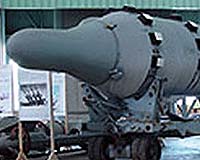 The missile showed up in the course of a televised military parade in Pyongyang’s Kim Il Sung square, better noted elsewhere for the joint appearance of ailing North Korean ruler Kim Jong Il and his son and successor Kim Jong Un. Compare this image of the nosecone on the right — a closeup from Anatoly Zak’s photo of an R-27 in a museum — to the glimpse of a pair of missiles at 0:49 in this video from North Korean television:
The missile showed up in the course of a televised military parade in Pyongyang’s Kim Il Sung square, better noted elsewhere for the joint appearance of ailing North Korean ruler Kim Jong Il and his son and successor Kim Jong Un. Compare this image of the nosecone on the right — a closeup from Anatoly Zak’s photo of an R-27 in a museum — to the glimpse of a pair of missiles at 0:49 in this video from North Korean television:
Another view appears at 1:12 in this video:
More than one missile type appears in the videos. According to the Associated Press, the Musudan wasn’t the only new one:
Japanese public broadcaster NHK reported Sunday that the parade included three never-before-shown types of missiles and launching devices.
One was thought to be a new “Musudan” intermediate-range ballistic missile with a long, narrow head, similar to a ball-point pen, NHK said. It has a range of 3,000-to-5,000 kilometers (1,860-to-3,100 miles) and would be capable of hitting Japan and Guam, NHK said.
Where that range estimate comes from, I don’t know.
“Musudan,” incidentally, is a Western designation. The press — starting with a December 15, 2005 story in the German tabloid Bild — tends to call it “BM-25,” probably a distortion of RSM-25. (The actual BM-25 was a Soviet rocket artillery system.) According to one source, the North Koreans market a 3,000-km range ballistic missile as “Scud-F,” but that’s unlikely to be their own name for it.
Update. Here’s another view of the R-27.
Further Update. [Oct. 11, 2010, 10:23 pm. I’ve moved the video that appeared here to this post, thanks to sharp-eyed commenter SJS.]
And a still photo, also courtesy Tal Inbar. A somewhat larger version appears here.
Late Update. According to the Chosun Ilbo, the Musudan was first displayed in an April 2007 military parade, but never previously exhibited to the world media. The Chosun, which describes the Musudan as having a range of 3,000 to 4,000 km, adds that the missile is deployed:
About a dozen of the missiles are apparently stationed at missile bases in Yangdok, South Pyongan Province, and Sangnam-ni, Hochon, North Hamgyong Province. The missile is 12 m long and 1.5 m wide and has the longest range in North Korea, outdoing the Rodong missile, which has a 1,300 km range.
The R-27, by contrast, was about 9 m in length (9.65 m, according to one source), and 2,500 to 3,000 km in range, depending on the mod. We’re looking at a new missile. The lack of a known testing record prior to deployment raises all sorts of questions. Was it tested in another country, for example?
Late Update | Oct. 11, 2010, 10:31 pm. Here’s Steve Zaloga’s nicely drafted comparison of the R-27 to the Musudan and its TEL.
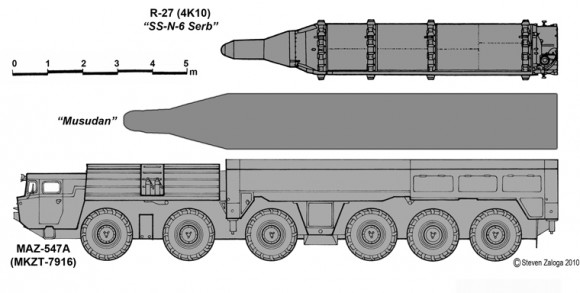 Late Update | Oct. 14, 2010, 10:16 pm. Yonhap has published a sharp still photo of the Musudan on parade.
Late Update | Oct. 14, 2010, 10:16 pm. Yonhap has published a sharp still photo of the Musudan on parade.
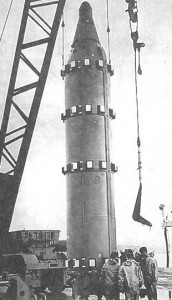
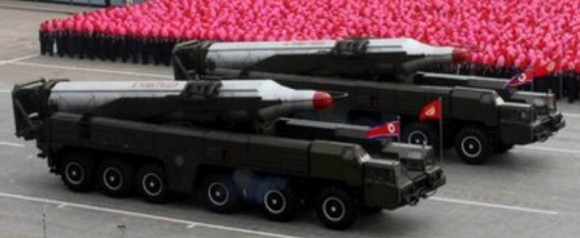
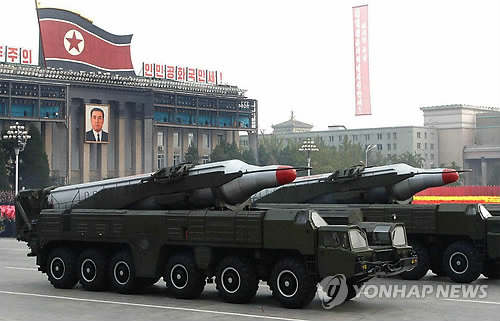

Some pictures I posted:
http://www.fresh.co.il/vBulletin/showthread.php?t=525672
Another picture I was able to cut and enlarge: http://www.fresh.co.il/vBulletin/showpost.php?p=3850854&postcount=7
looks like they have some version of the RIF or HQ-9 long range surface-to-air missile system as well
Where do you see that?
Now I see that a Chinese website has pictures of what looks like the various components of a modern mobile air defense system. But the truck carrying the pair of tubes for interceptor missiles is awfully small by Russian or Chinese standards.
http://bbs.voc.com.cn/topic-2629115-1-1.html
One is reminded, at least a little bit, of the vehicles displayed in Iran earlier this year:
http://bit.ly/b1L3f6
The BEST picture to date of NODONG. Hopefully a similar quality picture of BM-25 will pop out.
http://www.fresh.co.il/vBulletin/showpost.php?p=3851085&postcount=1
Agreed — except that I don’t think “BM-25” is the right name for this system.
This one’s not bad.
http://www.daylife.com/photo/09wm5CN00IbhB?q=North+Korea
Just to be sure: Every picture in the SLBM config complete with tube bumpers/spacers is a stock shot?
I’m not quite sure of your meaning. Both pictures of the Soviet R-27 SLBM currently displayed at this site appear to have been taken in Russia. Most images of the R-27 on the web appear here:
http://www.russianspaceweb.com/rockets_slbm.html
It’s probably fair to say that the Musudan IRBM is not a copy of the R-27, but rather an adaptation or derivation of it.
It seems stretched. The R-27 is 9.6 m or so long; the new missile seems to be about 1.4 times as long, based on the diameter to length ratio.
This is a quick, rough, not full all-aspects analysis…. But it’s pretty clear in the angles / photos I see here.
> It seems stretched.
The Chosun Ilbo article Joshua points out says, “The missile is 12 m long and 1.5 m wide.” Can you model what that means in terms of range/payload, assuming it’s just a stretched R-27?
Assuming 12m plus epsilon, that’s a 2.5 m stretch.
That gives you approximately 4.4 cubic meters more tank, if the nose and tail remained invariant. 2.2 cubic meters of NTO is about 3.1 metric tons; 2.2 cubic meters of UDMH is about 1.7 metric tons. Total propellant up of 4.8 metric tons, and dry mass probably up to 200 to 250 kg (to 1.25 to 1.3 metric tons). Total wet mass increase 5 tons plus or minus, to 18,250; plus notional 650 kg payload, gross of 18,900 kg. Thrust is plus or minus 26,850 kg at liftoff so acceleration is 1.42 G, higher than normal for space vehicles but lower than average for ballistic missiles. About 16,950 kg propellant, residuals of 3% is 510 kg. Burnout mass about 2,460 kg, Mr about 7.7.
A vacuum delta-V for this missile would be (Ve assumed 2846 m/s) 5,800 m/s.
Actual delta-V for R-27 was reportedly 4,235 m/s; its similar calculations are 5,425 m/s for vacuum delta-V, so there’s about 1,200 m/s of gravity loss and air drag on its flight.
The lower acceleration for the new missile will increase gravity loss – by no more than 10 m/s * 4.8 tons / 100 kg/s = 480 m/s, and probably more like 130-200 m/s. Those give burnout delta-V ranges around 4,400 – 4,470 m/s.
Very roughly, Back Of The Envelope estimate: Range is going to be increased about 8% to 11% for the same warhead mass.
Range/payload tradeoffs requires actual spreadsheet engineering, which I haven’t had time to do.
Just for reference, here are approximate IRBMish ranges to plausible targets from the DPRK and Iran.
DPRK – Okinawa: 1,300 km
DPRK – Taiwan: 1,900 km
DPRK – Guam: 3,400 km
DPRK – Adak: 4,200 km
Iran – Saudi Arabia: 2,000 km
Iran – Diego Garcia: 3,900 km
Iran – France 4,000 km (Complete coverage)
Iran – UK 4,250 km (Complete coverage)
Personally, I will never take a nation seriously that decided to name one of their major weapons the No Dong.
There. I feel better now.
Ah, but “Nodong” is an American designation for a North Korean missile.
It’s the Korean word for “labor” and the name of a village near the main North Korean missile test facility. Other villages nearby: Taepodong and Musudan-ri.
All this was explained here: http://lewis.armscontrolwonk.com/archive/1500/nork-irbm-musudan-1
@ joshua. Korean pronunciations of Korean word for “labor” and village name of Nodong missile are same. NODONG. Their Korean spellings are same, too. But, these two words are different words, like “dye” and “die”.
Many Korean words have spelling both in Korean and Chinese characters, because Korean had used chinese character to write a word before Korean charater was invented 5 hundred years ago.
Chinese spelling of those two ‘Nodong’ are different. I mean that village name does not mean “labor”.
Thanks for the explanation!
Somewhat off topic, but did anyone notice the tanks the videos? There many well known tanks shown including T-62s (like Korean variants of them) but also a more squarish looking tanks that seems somewhat similar to the T-62 but with a more square shaped turret and a different looking front of the hull. I think it is the M2002 tank that was long claimed to a T-90 equivalent but images of it appeared on the net last year that showed this not to be true but still a very interesting showing..
Also, the closeup HQ images of the Nodong is very interesting..it has the same shaped warhead as the so-called Shahab-3B/Ghadr-1 but I noticed that is appears to have larger fins than its Iranian counterparts. The angle also makes the missile look shorter but that could just be a perspective problem.
Interesting. What would be really helpful is a complete video of the event, which was televised live.
You know, I believe this is another first. If the North Koreans have ever exhibited a Nodong with an Iranian-style triconic warhead before, I don’t believe I’ve seen it.
I’ve now added a post on this subject:
http://pollack.armscontrolwonk.com/archive/3388/another-north-korean-missile-first
Thanks for pointing this out. Don’t know why it didn’t register with me as soon as Tal surfaced the photo. This one’s a group endeavor.
Don’t miss this story from the Chosun Ilbo:
http://english.chosun.com/site/data/html_dir/2010/10/11/2010101101060.html
They think it’s 12 m long (plausible) and has less range than the Nodong (if it’s a stretched R-27, slightly implausible, it should be much more range than Nodong…)
Joshua:
The video (3rd down: “North Korean parade unveils Kim Jong-un”) w/display of up to eight of the new missile appears to be the Nodong w/triconic warhead vice the BM-25/Musudan described above and below. Looks like all 8 have aero fins and different TELs…
w/r, SJS
You are correct. Thanks for pointing that out.
Googling around for the “public” picture of the Musudan missile, I was struck by the obvious incorrectness of the narrative for it’s origin constructed by the folks at Wikipedia, with footnotes from the usual suspects. They claim this missile was chosen to fit available carriers based on the MAZ-543a truck, which is an 8 wheeled vehicle. The photos and films linked to your article show a 12 wheeled transporter. Even the other new missile is on a 10 wheeled transporter.
Is this missile in the parade even the same missile discussed elsewhere as the Musudan?
For that matter, I am curious whether a trained observer can ascertain with certainty that the new missiles are liquid fueled?
The reasons for my second question are the following. First, the stated absence of known tests in the DPRK. Second is the appearance of the “Iranian style” triconic RV. Third, the appearance of large, high performance solid guided missiles in Iran and Pakistan.
It is my reading of the history of missile technology that large high performance solid guided missiles are an entirely separate technology from liquids, which implies a whole separate program and enterprise to develop.
My reading of the discussions is that there is deep collaboration between Iran, Pakistan and the DPRK. I have searched and found that the DPRK has in the past undertaken not to develop long range missiles, so my presumption is that the main point of their tests is political. On the other hand, I have been unable to find any undertaking by the Islamic Republic of Iran not to develop or test long range missiles, and they have lots of room for test launches, which makes Iranian testing of North Korean designs an obvious path if they are closely collaborating.
Thanks to Ben (see below), we can pretty confidently say that a missile of this appearance and proportions is the Musudan. Certainly, it’s nothing we’ve seen before, and something close to what one would expect, based on previous reports of a missile based on the R-27 being present in North Korea (and by some accounts, at least, in Iran).
Its resemblance to the R-27 is probably the best reason to think it’s liquid-fueled.
North Korea has long since abandoned its missile test moratorium. They’ve tested at least three missiles of greater range than this one — two in the form of satellite launchers.
Iran’s “Safir” space launcher actually may owe something to the R-27, as described here.
The Musudan is evidently not a simple copy of the Soviet R-27. The TEL is obviously based on the MAZ-547 family which provides some size comparison. Here’s a rough comparison of the Musudan vs. the R-27/SS-N-6.
http://i127.photobucket.com/albums/p160/szaloga/Musudansmall.jpg
The “SAM system” has many of the same flaws as the Iranian one that appeared a few months back, the workmanship looks better but it still does not look ‘right’. For starters the chassis it is mounted on, NK has the ability to manufacture off-road TELs as shown by their IRBM launchers (though the KN-02 SRBM systems are mounted on the same vehicles as this SAM system) yet this is clearly a road only TEL. The TELs themselves appear to lack the required apparatus to actually erect the missile tubes (though again, there could be a large hydraulic ram under that raised middle missile), the hydraulic rams on the radar look insufficient to raise it to a decent angle and it lacks many of the detail characteristics of the Russian radar it is clear based on. All in all it just does not look ‘right’. The greatest point of interest is that it looks so similar to the Iranian effort, like the current batch of IRBM’s, suggesting that there is still very close cooperation between the Iranians and North Koreans.
Is this really a new missile?…I was under the impression that the Musudan is a stretched R-27/SS-N-6 in order to increase the operational range (bases in guam?), but at the cost of greater fuel load and lower acceleration. gloablsecurity went into some depth about it…
http://www.globalsecurity.org/wmd/world/dprk/nd-b3.htm
It was first reported in the media in 2003, but this is the first time there have been publicly available images. Thanks for linking Charles Vick’s analysis — I hadn’t realized that MDA had already described the missile’s proportions.
Thank you for the enlightening responses, especially Theodore Postol’s assessment report, which seems very sober. There is quite a disparity between his report and the also above linked global security page. Mr. Postol’s report would seem to cast doubt on the R-27 copy supposition, given the limitations of “stretching” he discusses, as I read them.
I remain a bit mystified about my question concerning solids. I tend to believe the videos showing what appear to be solid booster launches in Iran, and Pakistan certainly has everybody convinced they have a deployed large solid missile, though with considerably more modest performance stated than the rather excitable reports in the world press for any of the Iranian or Korean missiles.
I was actually wondering why the Musudan’s TEL seems a bit too long for that particular missile..So it possibly being based on the MAZ-547 does explain it. However the problem I ran into was this TEL has too few of wheels/axles..But I have found an image of a MAZ-547 with a nearly identical wheel arrangment to the Musudan’s TEL.
http://www.flickr.com/photos/avi_abrams/427809810/sizes/o/
However, did anyone else notice how it seems to have a stepped cabin? What would the purpose be for the upper cabin structure seen on the Musudan TEL? The MAZ lacks this so I am just curious…
My modeling suggests that a stretched SSN-6 might have a range of up to 4,000 km with a 650 kg payload. I have a post discussing this at: http://allthingsnuclear.org/post/1300035704/range-estimates-for-musudan-missile
David, it looks like your Isp estimates for the missile come out high –
See: http://www.b14643.de/Spacerockets_1/Diverse/KB-Isayev_engines/index.htm
They list Ve of 2,686 m/s at sea level and 2,846 m/s at vacuum conditions, assuming I read the table right. You seem to have assumed 280s SL 312s Vacc, which correspond to 2,746 m/s and 3,060 m/s respectively.
Plenty of high expansion ratio space engines burning hydrazine / tetroxide get 312s Isp in vacuum, but few that are designed for booster use do.
As an aside – I am concerned that I overestimated the structural mass increase due to the lengthening. Does anyone know if there’s a SS-N-6 in a museum anywhere that someone can go measure tank wall thickness on?
Conversely, I am not sure if the NK designers were able to produce the same quality materials and welds for the structure as the Russians did at the time. Though the opposite could be true – there are far more high quality weldable Aluminum alloys on the open market now, and welding technology proliferation is pretty rampant. Even if they can’t make the best alloys, I bet someone in China could for them and (probably) would.
Also, responding again to David Wright…
Delta V for high mass ratio stages requires high accuracy estimates of the mass ratio. I don’t know how many significant figures you used “behind the scenes” – I kept track to about 10 kg, though my estimates have higher error bars than that to be sure. What you posted listed to the 0.1 ton roundoff only.
All of this is way too much BOTE for my taste, to be honest; we’re in a performance corner here with a single stage, thin wall, apparently balloon tank missile with very high mass ratios. Performance change is significant with minor mass ratio changes, and without doing a full analysis on the loads and structures and knowing the materials, it’s hard to be sure what the tank weighs.
I came to the same conclusion as George William Herbert that my earlier specific impulse was too high, and in fact a little while ago posted a second estimate of the Musudan range based on a more realistic value. As I note there, my earlier post used the higher value since I was trying to match the reported 3,000 km range of the R-27 with a reasonable structure fraction. What I’ve concluded after digging into things is that the 3,000 km range figure is too high, and 2,400 km is more likely. That range is consistent with a more realistic value of the specific impulse.
I do keep track of masses to higher accuracy than I stated them here; I find that if you quote too many significant figures, people tend to assume they are “true” rather than estimates in a model. While the results certainly depend on the detailed assumptions, I’ve done sensitivity analysis on my results, and find the results don’t change as sensitively as you suggest.
What the new estimates show is that the nominal range is around 3,200 km for a 650 kg payload, which agrees with an MDA estimate from a couple years ago. My new post is at http://allthingsnuclear.org/post//more-on-musudan-range-estimates
> What the new estimates show is that the nominal range is around 3,200 km for a 650 kg payload…
Going back to Google Earth, the range to Andersen AFB, Guam from the extreme south of the DPRK, right next to the DMZ, is just a smidgen over 3,200 km.
Which goes back to the plausible but not certain hypothesis that the Musudan was designed with one or more specific missions in mind.
Allen:
According to the Chosun Ilbo, the Musudan is deployed at bases in “Yangdok, South Pyongan Province, and Sangnam-ni, Hochon, North Hamgyong Province.” (Actually, that’s in South Hamgyong.)
Neither of those is too close to the DMZ. Should we imagine them rolling up to it during a crisis or a shooting war?
> According to the Chosun Ilbo, the Musudan is deployed at bases in “Yangdok, South Pyongan Province, and Sangnam-ni, Hochon, North Hamgyong Province.” (Actually, that’s in South Hamgyong.)
> Neither of those is too close to the DMZ. Should we imagine them rolling up to it during a crisis or a shooting war?
Either that or the Musudan would have to have a range of 3,350 – 3,400 km to attack Guam, and I don’t see another plausible target in the general 3,000 – 4,000 km category. I leave it for our rocket scientists to comment on whether a couple of hundred kilometers more than the reported 3,200 is significant in terms of modeling the missile.
Of course, the DPRK may have no thought of attacking Andersen AFB, which would leave us wondering why they’ve developed the Musudan.
Unpleasant thought of the day…
Consider, for a moment, the R-29…
What if Musudan isn’t single stage?
I was gnawing on the details of this discussion and noticed a detail that I would think is discordant with the R-27 copy theme. There is a fairing-tunnel running the length of these paraded “musudan”. That feature appears to be missing from the R-27, and I would think undesirable in a sub launched design?
Actually, something that looks similar (not identical) is apparent in the black-and-white photo of the upright R-27, above.
Steve Zaloga also includes something of this sort in his R-27 line drawing, I notice. Steve, can you comment on that?
Does this threaten Europe? That is, if these missiles show up in a NK proxy state – Syria, Lebanon, Libya, etc.?
It’s been reported as far back as 2005 in the German and U.S. media that some of these missiles were transferred to Iran, but we’ve yet to see them displayed there. NASIC documents that have been released to the public do not mention them as being there.
Yes, or at least mostly, depending on the actual range of the thing. Ranges that have been been discussed reach all of Europe except some of Scandinavia from Libya. The nominal 3,200 km range reaches all of Germany, none of the UK and all except western France from Syria. 4,000 km gets all of Europe except maybe Portugal.
Do you think this will prompt Europe to start arming? That is, with the U.S. pulling out of the region as Iraq and Afganistan campaigns wind down?
Europe is already pretty well-armed, as regions go. There is renewed interest in missile defenses for NATO these days, but I don’t think it has much to do (directly) with this development.
See: http://www.nytimes.com/2010/10/13/opinion/13iht-edrasmussen.html
What would be really interesting is if these missiles show up in Venezuela.
Indeed. I haven’t seen any indication of such a relationship, but the NKs really will sell missiles to anybody. There were news reports ca. 1995 of a Scud sale to Peru, but it does not seem to have come to fruition.
Chavez is really reaching out for as much as he can get – http://news.yahoo.com/s/ap/20101020/ap_on_re_mi_ea/ml_iran_venezuela